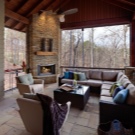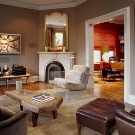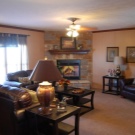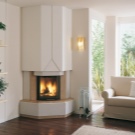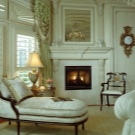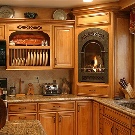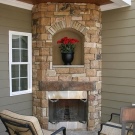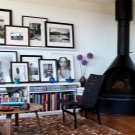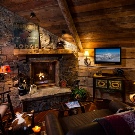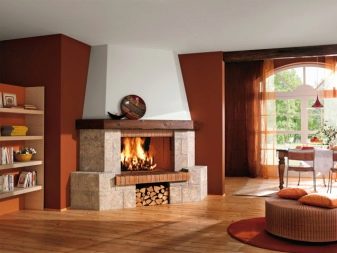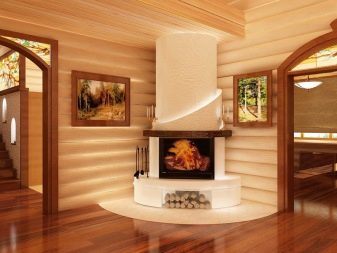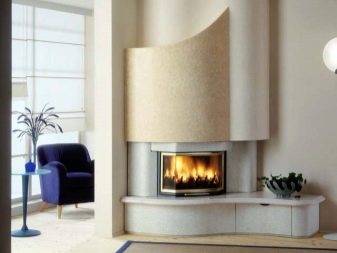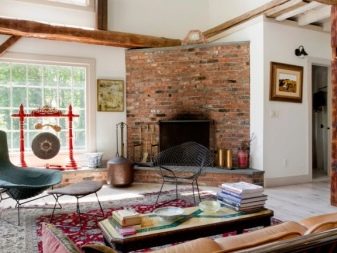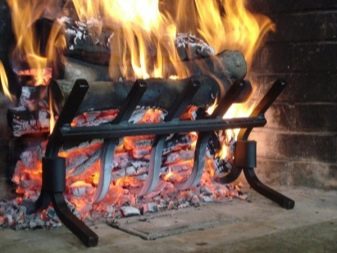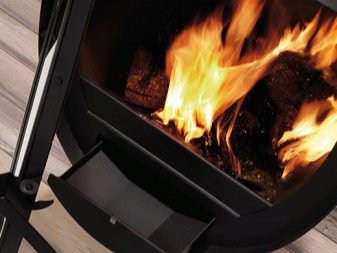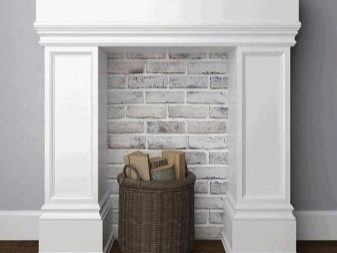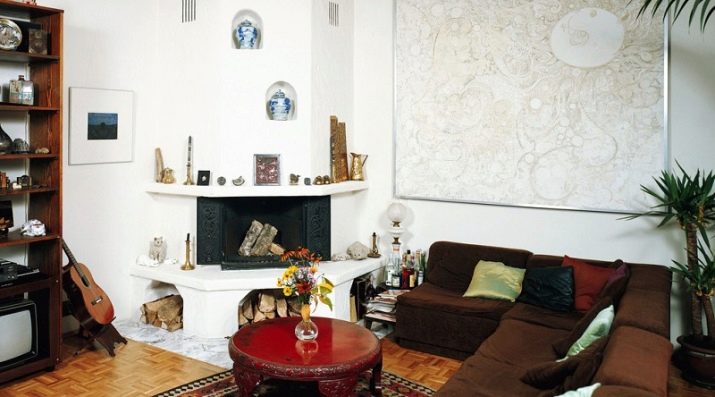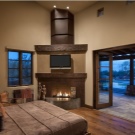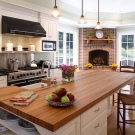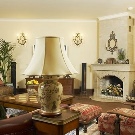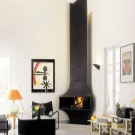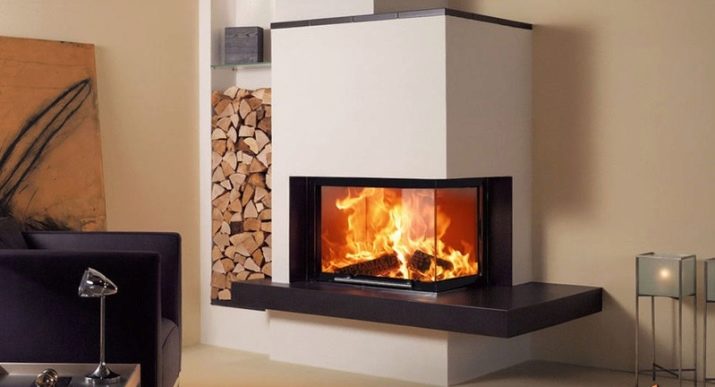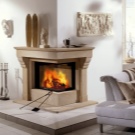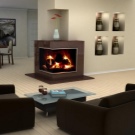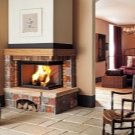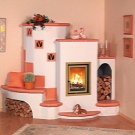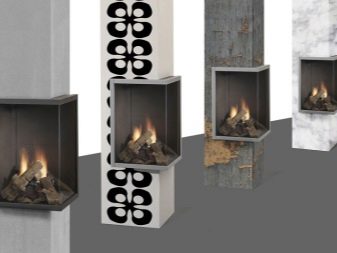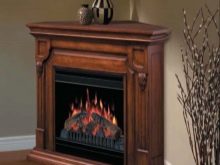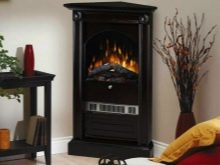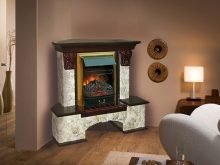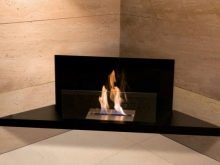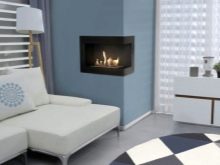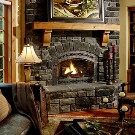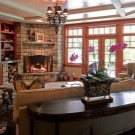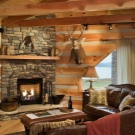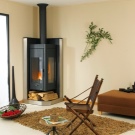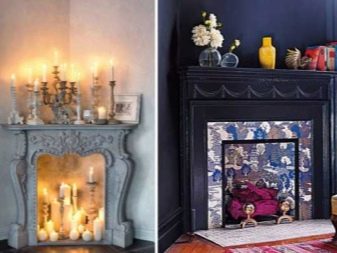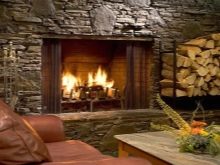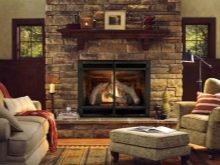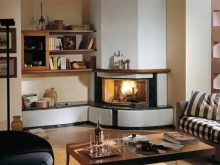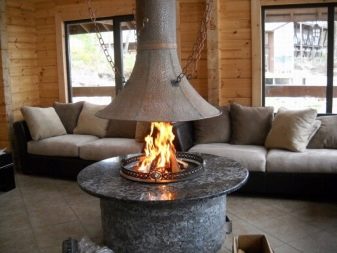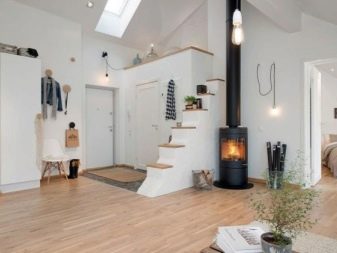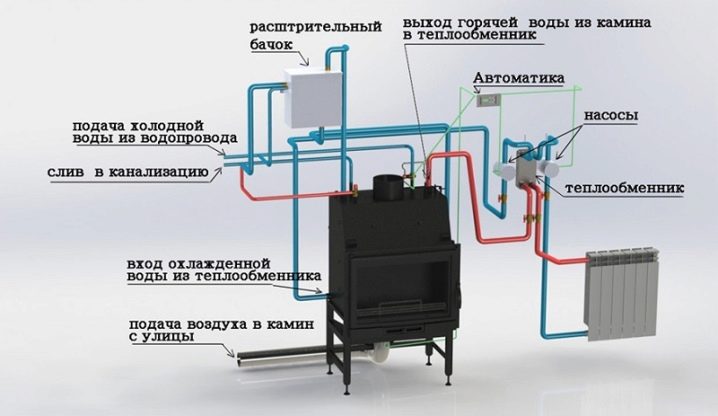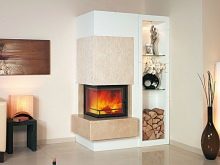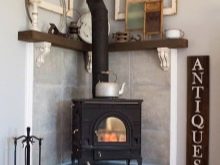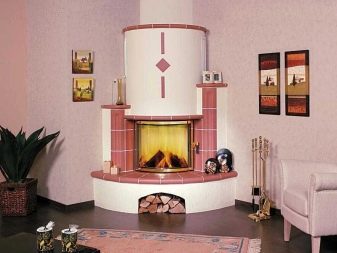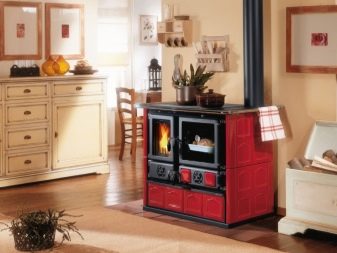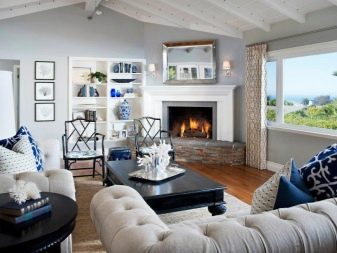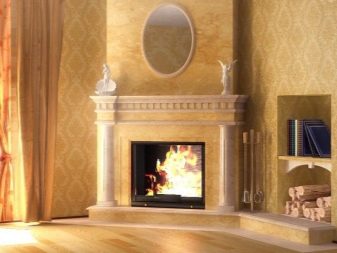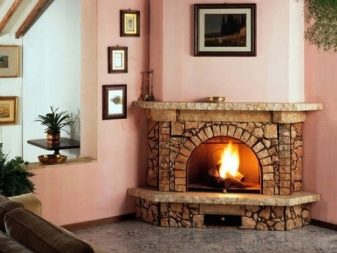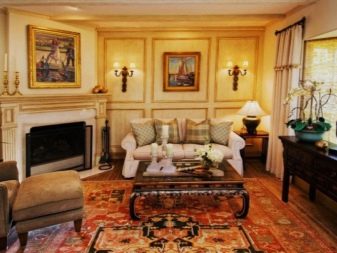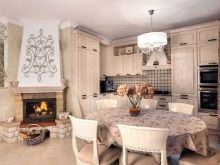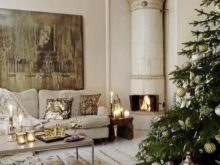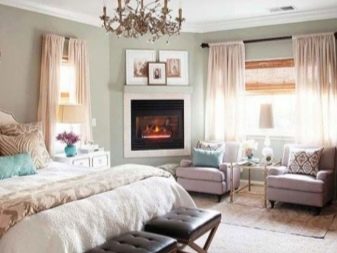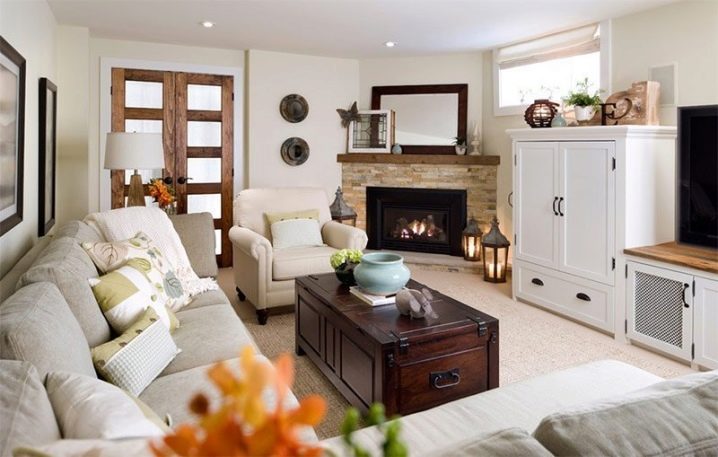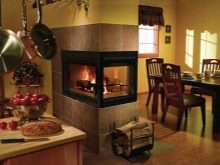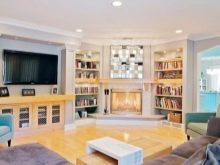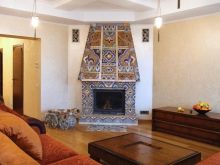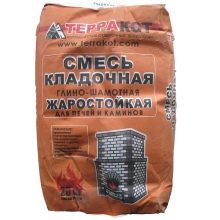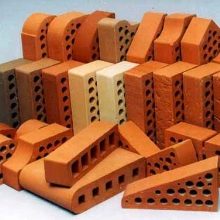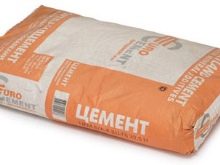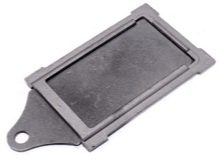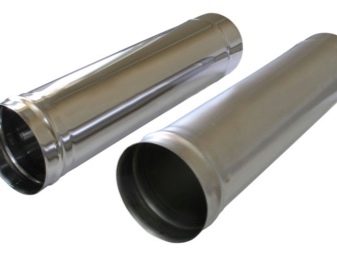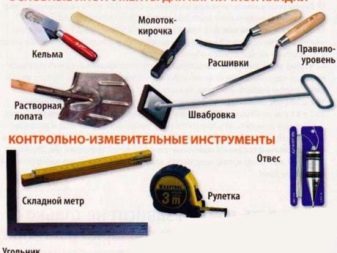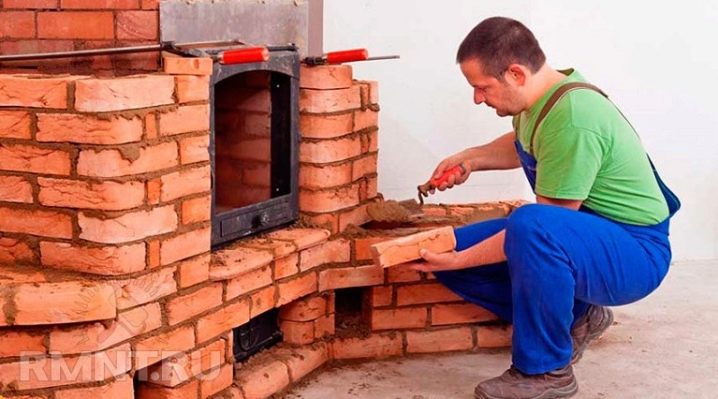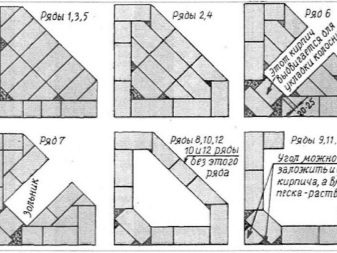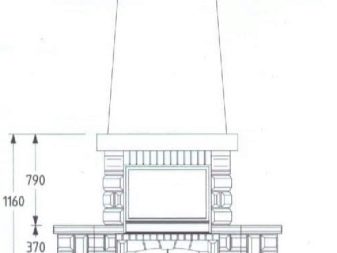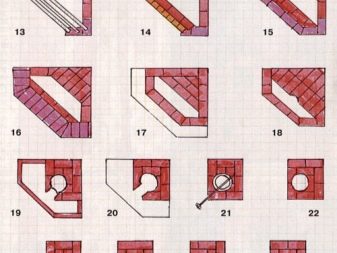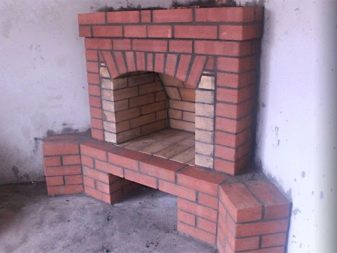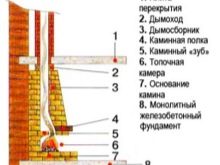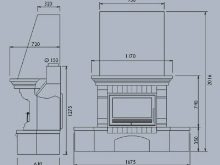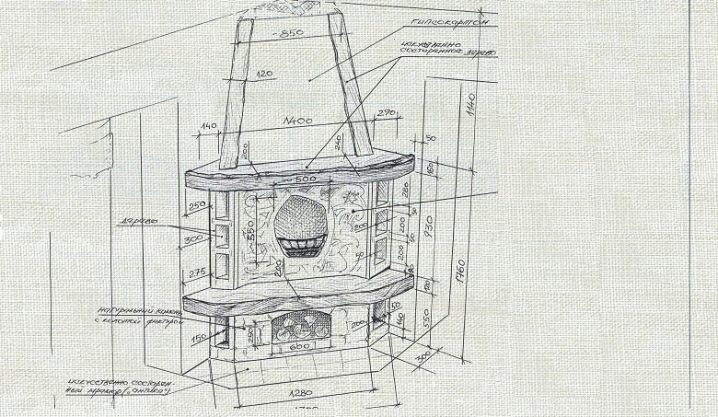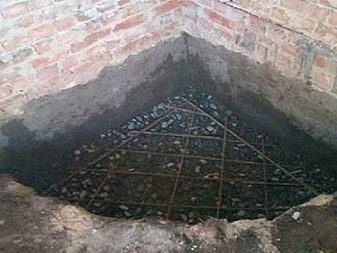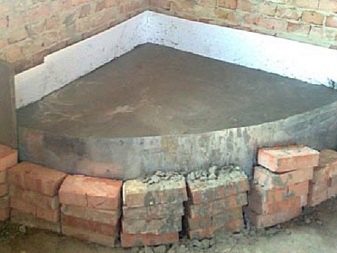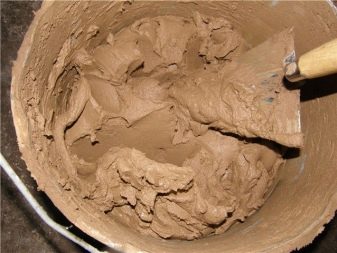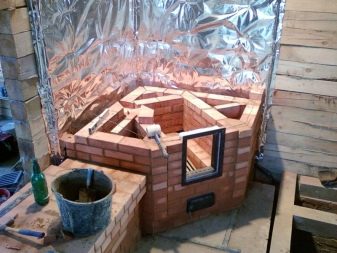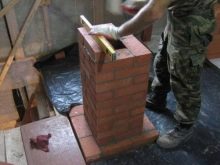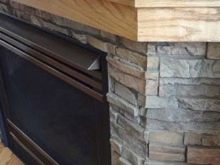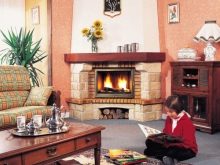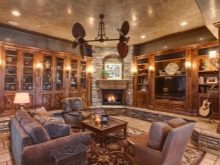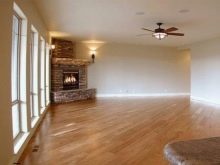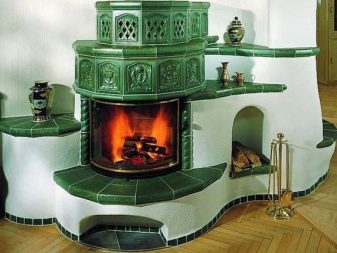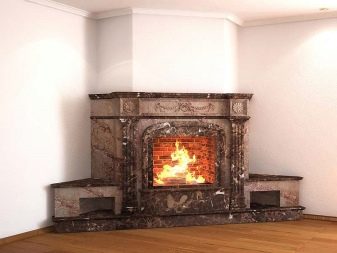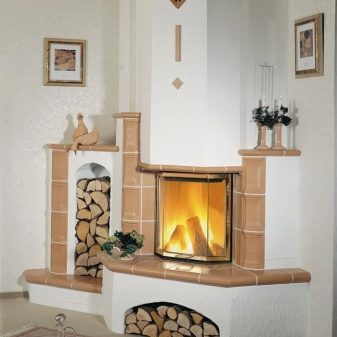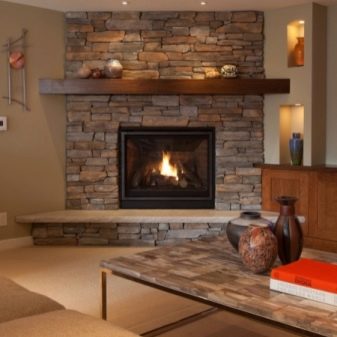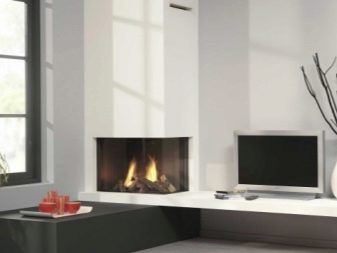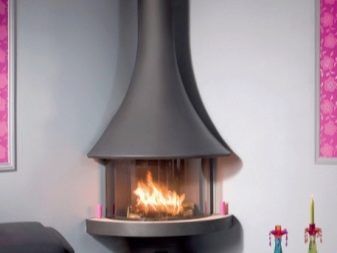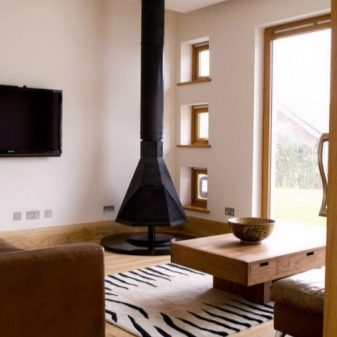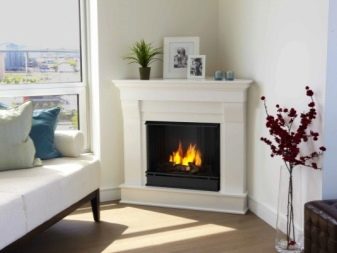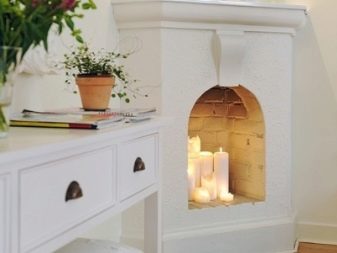Corner fireplace in interior design
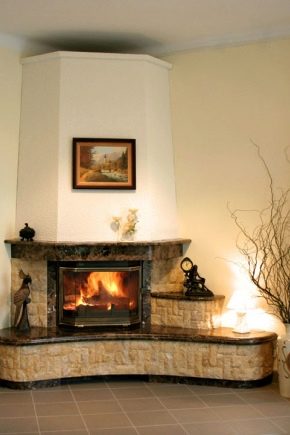
Sit on cold evenings by the burning fireplace, listen to the crackle of a live fire, admire the tongues of flame, enjoy fragrant tea in the company of your favorite people - what more could be more wonderful! Burning fireplace creates a special atmosphere and gives the room an aesthetic value. And besides, such a simple piece of interior attracts attention and speaks about the status of the host. But for many, the fireplace is still an unaffordable luxury.
Of course, this is not a cheap pleasure, but you can build it yourself. To do this, it is enough to have a little experience in the construction industry, study the implemented projects and be able to use the instructions.
Special features
Corner fireplace - this is a great solution for owners of small living rooms. It gives both a large cottage and a small country house comfort, warmth and comfort, as well as creates a unique interior.
Corner fireplace has several undeniable advantages:
- compact sizes: the corner fireplace will ideally fill an empty corner in the room;
- reliable source of heat: the corner fireplace has an optimal heat dissipation, which is many times greater than conventional stoves or electric heaters;
- it is possible to install a corner fireplace not only in the living room, but also in the bedroom;
- high level of security;
- quietly saves usable space and does not take up much space;
- a large range and a variety of finishing options for different rooms;
- heats in addition adjoining rooms, since the construction involves two walls;
- hides the flaws of the walls and the shortcomings of the room design;
- wide visibility of the fire, which allows you to look at the flame from anywhere in the room.
The design of the fireplace consists of several parts.
- Firebox. Sometimes open or closed. The type of furnace does not affect the heat transfer, but increases the fire safety in the room.For a closed firebox, you must additionally take care of purchasing durable heat-resistant tempered glass or ceramics. If you plan to equip an open firebox, you should put a brick or metal tile in front of the fireplace: occasional sparks from fire will not grow into a flame, which will protect your house from fire.
- Ashpot Necessary to collect large amounts of ash, which is formed after the combustion of logs. The ashpit is a small chamber and is located directly under the fire. In case of excessive clogging through the ash pan, the air stops flowing into the firebox, and the fire goes out.
- Grate. It serves as an insulating layer, which burns fuel for the fireplace.
- Portal. This is the very design of the fireplace, in other words, the body.
- Chimney. It is made of steel or brick, its height must be at least 5 meters.
Kinds
On the modern market there is a large variety of furnaces-heat generators. Despite the angular shape of the fireplace, the bowl for the hearth can be rectangular, trapezoidal, square, and also semi-circular. Fireplaces are divided into two types.
- Symmetrical. With this design, both sides ideally resemble each other. Such type of fireplaces is suitable for any room and possesses the best characteristics.
- Asymmetrical Often used when zoning a room while maintaining the integrity of the space. Such designs are unobtrusive and appropriate border in the interior and look better in a large room. Also, fireplaces are divided into several types depending on the fuel and the design of the furnace. The energy efficiency of the entire system depends on this. Consider the types of fireplaces by type of fuel.
Gas
Easy to maintain and provides the necessary heat. At the same time there is no soot, and there is no need for laborious cleaning. In addition, it works silently and warms up as quickly as possible. Of the minuses it can be noted that obtaining permission to install a gas fireplace can take a lot of time and effort, since special safety requirements are put forward for rooms with gas.
Electrofireplace
To install such a structure in the room does not need to obtain a special permit, so electric fireplaces are often installed in apartment buildings.But, in fact, it is an unusual in appearance primitive electric heater, which is the most realistic copy of a burning flame and glowing embers. Of the benefits you can also note the optimal price and ease of operation.
It is possible to arrange such a decorative fireplace both on the floor and on the wall.
Bio Fireplace
Modern models have a stylish look and are able to complement any interior. They are used directly to decorate the interior, and not to heat the room. For such a fireplace does not need a chimney, so they can be installed in any room. But the high cost of fuel and the unsafe design of some types of biofireplaces deter customers. In addition, he is not able to warm the room.
By their design, such models perfectly complement the living room in the style of high-tech or minimalism.
Wood burning
It is installed, as a rule, in the country, in private houses or country cottages. The greatest difficulty lies in the construction of the foundation and the installation of the chimney. In addition, for a classic fireplace is necessary to maintain a supply of firewood or briquettes.
Falshkamina
Outwardly, it is not much different from the present, but does not give heat.For a city apartment is a great option that does not require care, and is also affordable and completely safe. In addition, a similar design of the fireplace can be made with your own hands from boxes, cardboard, foam, plywood, old furniture and much more. For this you only need to stock up on the necessary materials and patience.
Some types of fireplaces can be used not only for heating the room, but also for cooking. This is a great way to spend time in the cold evenings with your family. A cup of fragrant tea, spicy cake and fried marshmallows on a fire - such warm memories will always be stored in the soul of your children.
Fireplaces are also classified by installation method.
- Inline. Such models hide the chimney behind a decorative column. Only the firebox remains in the access zone.
- The walls. Perhaps the most common option. Such models can be heated by wood or gas. A wall fireplace takes up much less space and has free space above the mantel. This design can be finished with various materials: stones, brick, plaster.
- Island Installed anywhere in the room and have an original appearance. As a rule, fire in such models is completely covered with heat-resistant glass. But with an open installation method, they require more secure handling. But island constructions look harmoniously only in large rooms, besides for caution it is necessary to free about 60 cm of space from fire.
- Corner. A great option for small spaces. Using only one corner, they leave more space in the room.
Also, some designs of fireplaces can be used to heat a large part of the house. According to its construction device will be not much different from the classic.
A more modified model has a water circuit that connects to a radiator installed in the house. Depending on the capacity of the design and the number of batteries, the living area is selected, which must be heated. At the same time, there is a water jacket and air channels between the walls of the cast-iron fireplace, which are necessary to maintain the fire. The heated water passes through pipes to the radiators and distributes heat throughout the room.In addition, part of the water can be used for hot water.
Design
Before installing the fireplace, you must decide on the design.
In this case it is necessary to consider:
- geometrical dimensions;
- facade;
- form;
- type of;
- functional performance;
- aesthetic parameters.
Designers do not recommend placing an emphasis in the room directly on the fireplace - this will deprive the interior of integrity and harmony. Although, of course, the fireplace will be the main element in any room. Even an imitation fireplace makes a simple room more comfortable and attractive. And to give the interior weightlessness and harmony - choose a glass fireplace of light shades.
A fireplace shelf can be decorated with statues, vases of flowers, photographs or beautiful candles. There is also a place for precious antique clocks and family relics.
Some designs of fireplaces can be improved by adding a hob or even an oven. Then you can cook delicious dishes with smoke, without leaving your home. This fireplace is more appropriate to place in the dining room or kitchen-living room.
Style
Corner fireplace can harmoniously fit into any interior, regardless of style.You can use both natural and artificial finishing materials. The most popular are: brick, drywall and decorative plaster. The main thing is that the individual elements of the fireplace are not out of the general style of the interior.
In the classic English style fireplace is made of red brick. Such designs look reliable, elegant and restrained. They are able to create a comfortable and cozy atmosphere. But it is also important to bear in mind that a brick fireplace looks appropriate only in a large room. In addition, its installation will require a lot of strength and finance.
Also for a classic style, an excellent option would be a wooden fireplace, especially if the whole interior is designed in the traditional spirit.
Country style “country” and “provence” are perfect for the living room with a fireplace. Here, when finishing the fireplace is appropriate combination of natural materials: stone and wood.
In modern styles, designers often prefer fireplaces with decorative trim - they look more lightly. The living room can be decorated with warm or cold colors. For furniture, designers are advised to choose quiet warm shades: they perfectly emphasize and complement the overall atmosphere of the room.
Which to choose?
Buying and installing a fireplace will require significant financial costs, so in order not to be mistaken, it is important to make the right choice.
When choosing a fireplace for a country house, first of all you need to decide:
- what room will be the fireplace;
- what basic functions should it perform;
- what kind of fuel will work.
The fireplace can be installed in several rooms: it can be a hall, bedroom, dining room, bath, kitchen or outdoor terrace. However, in each case, the conditions of its installation are individual.
In a closed and well-heated place, the fireplace should have a good burden, which will eliminate the smoke in the room. But at the same time the pipe should not pull out all the heat from the flame. Good traction also contributes to the rapid ignition of the fire and maintaining heat.
If the fireplace is installed in the room as a decorative element, but it does not have to have a chimney, of course, only if it does not drown. And for space heating, water heating or cooking, a lot more requirements are put forward.
A rarely used fireplace with a chimney should not cool the room and take heat, so consider this point when choosing the type of fuel.Experts say that to determine the power of the fireplace insert, it is necessary to divide the cubic space of the room by 25. So, for example, the volume of a room is 50 cubic meters (in this case, cubic rather than square are taken into account), so 50/25 = 2 kW. It is this power that a fireplace should have to maintain the heat in a warmed building in a temperate climate. For the harsh climate, it is better to choose fireplaces with cast iron or steel firebox: they heat up faster and maintain heat better.
Masonry patterns
There is a certain order for each laying pattern - it will facilitate the construction process.
For a visual example, we will analyze the option of laying a corner fireplace according to the following characteristics:
- the area of the room is 28-35 square meters;
- dimensions of the fireplace base - 90x90 cm;
- height (without flue pipe) - 163 cm.
To install a fireplace, you need to prepare the following building materials and tools:
- chamont (fire-resistant) brick for the firefighter of the brand M220 - 60 pieces;
- solid brick - 396 pieces (taking into account the additional 10% that must be laid on the marriage and errors, in this case the number of bricks for the pipe is not taken into account);
- coarse and fine sand, crushed stone, gravel;
- cement mixture brand M300-M400 and red refractory clay in the same proportions;
- rod fittings;
- plywood sheet and wooden bars;
- metal sheet 40x60 cm in size and 3 mm thick;
- steel corners with dimensions of 5x5x0.5x60 cm and 5x5x0.5x80 cm (2 pieces);
- smoke valve size 13x25 cm with a long handle;
- asbestos sheet;
- chimney pipe;
- finishing materials for the final stage: decorative tiles, brick, plaster;
- construction trowel;
- shovel;
- rubber mallet;
- grinding machine;
- medium spatula;
- roulette;
- corner;
- plummet;
- jointing;
- tanks for the preparation of solutions.
All work begins after the foundation has been fully prepared for the future fireplace. The first row of bricks is a basement - it fits below the floor level.
To facilitate the work, you can number each successive row on the wall using chalk or a simple pencil.
- The first row allows you to build the main shape of the future fireplace. According to the project, the size of the base is 90x90 cm. With the help of the construction level it is necessary to draw diagonal lines, orienting to which the first row of 91x91 cm in size is being laid.
- Professionals are advised to resort to a little trick, so that the construction has perfectly flat walls: it is necessary to fix sheer threads on the ceiling that will act as a pendulum and greatly facilitate the work.
- The second row should already have walls measuring 90x90 cm.
- From the third row begins the formation of niche walls for firewood.
- On the fourth row laying of bricks is repeated. After the camera for firewood, you must block the metal sheet and steel angle of a suitable size.
- The next row fits the same pattern as the first row, but the frontal part increases 2 cm forward.
- Next comes a series that follows the previous one. By the same analogy, the frontal part is increased by another 2 cm. At the place of the future firebox, the usual solid brick is replaced with chamotte.
- The seventh row continues to build the firebox. Between ordinary and fire-resistant bricks should leave an additional gap of 3-4 mm - this is a necessary measure for the expansion of the material during heating.
- The following three rows are repeated by analogy and complete the construction of the firebox.
- On the 11th row it is possible to proceed to the formation of a chimney tooth.For this, fireclay bricks in the far corner on two rows must be grinded inwards.
- On the 13th row there is a steel corner on the front side of the fireplace and the overlap of the firebox is formed.
- Thus, on the 14th and 15th rows an enclosed fireplace area is laid and a tooth is formed. On the sides, an ordinary brick shifts a few millimeters to the walls of the room, so that by 16 rows it is possible to increase the area for fireclay bricks.
- On the 17th row, the side walls increase the size of the fireplace by another 3 cm. The process fits into a row of one full brick. In total, this row consumes 11.5 red bricks. The rest of the place in the form of a triangle is assigned to the five refractory bricks. But first, three bricks need to be filed and give them the necessary shape.
- On the 18th row, a beautiful overlap of the fuel chamber is formed, and then exclusively solid brick is used.
- 19 row is the basis for the mantel and gradually overestimated so that the next row will go to the formation of the chimney.
- Gradually, at 21 and 22 rows, the size of the chimney is reduced to 26x13 cm. To do this, in the far corner bricks are cut along the entire length at an angle of 45 degrees.
- Up to the 28th row, a chimney is gradually formed, and the side walls of the structure on each row are reduced by several centimeters. Thus, from the 25th row, only the chimney pipe is being laid.
- At the 28th row, a smoke valve is installed, but before that one of the bricks needs to be trimmed so that the handle of the valve always remains movable.
- The following rows are made up of five bricks that do not need to be customized.
- Of course, to facilitate the work, you can use a ready-made cast-iron firebox: it will significantly reduce the time of laying the firebox of refractory bricks. When choosing a steel firebox, experts recommend still imposing bricks on the internal structure in order to reduce the metal's contact with fire.
This is one of the easiest ways to stack a corner fireplace. The appearance of the structure can be supplemented with arched elements, increase the size of the niche for firewood, and also add an ashpit - it all depends on your preferences, means and desires.
Projects
As with any solid task, the construction of buildings begins with drawing up a sketch and project.To do this, on a regular sheet in a cage depict the space of the room and a place for a fireplace.
All drawings must be constructed correctly and correctly and take into account all dimensions.
- When choosing a project, it is first necessary to determine the angle in the room for the future fireplace. As a rule, the fireplace is located in a remote corner without windows and away from flammable objects. The optimal distance is 65-70 cm.
- The sketch should indicate the form and preliminary design for drawing up estimates of building and finishing materials.
The fireplace should be shallow and wide. In this case, the heat transfer area will be maximum.
- Draw a chimney tooth in the drawing - this is a small chamber located on the back of the firebox. It is necessary for the circulation of flue gases and cold air. With the gradual cooling down the chimney pipe, the hot gas goes down, creating turbulence flow. Without an additional chamber, the smoke will hang in the chimney and prevent the natural circulation of hot and cold streams inside it.
- Calculation of air flow - a necessary item in the preparation of the project. The size of the fireplace should correspond to the area of the room.So, in a small room it is difficult to achieve the necessary ventilation - installing a fireplace in this case can be dangerous for the life and health of the household.
- The fireplace can be installed not only in a private house, but also in some apartment buildings. Although the coordination of the project will require a lot of effort. To install the chimney, you must obtain the appropriate permits and comply with all fire safety requirements.
- If this option is impossible to implement, you can choose an electric fireplace. With such a model will be much less hassle. In addition, imitations occupy significantly less space. As a finishing material for them, you can use drywall.
How to do it yourself?
The construction of the fireplace should be trusted by professionals. But if you have certain knowledge and skills and are confident in your own abilities, you can do all the work yourself.
Detailed step-by-step instructions will help realize even the most courageous project.
- First you need to prepare a foundation - this is the most crucial stage of work. To do this, you will need to dig a hole 10 cm larger than the future foundation.
- Before starting, clean the sand from possible debris and sift. The sandy layer with granite rubble is poured on the bottom of the prepared excavation. Its thickness must be at least 30 mm.
- This is followed by a layer of rubble and cement mortar. It should not reach the level of the floor, but be lower: at a distance of about two bricks. Layer must be carefully aligned.
- The walls to which the fireplace will abut should be protected from overheating. This can be done using a reflective screen of foil or ceramic tiles. The floor near the fireplace must also be protected from sparks of fire with ceramic tiles.
- After complete drying of the cement base (approximately 5-7 days), you can proceed to laying bricks. But before that, lay a layer of roofing material, which will act as a waterproofing material. On the walls near the fireplace you can indicate the numbers of the rows, which will greatly facilitate the construction phase.
- You can start making masonry material: it includes sand and clay. The main element in this case is clay: the quality of the entire masonry material will depend on its quality.Such a solution can be purchased already in dry finished form and used, following the manufacturer's instructions.
- Each seam should not exceed 5 mm, otherwise at elevated temperatures it may crack. To ensure that all seams are of the ideal size, you can use pre-prepared wooden slats, which will be of a suitable thickness. After the masonry mixture dries, remove the slats from the bottom row and continue laying the bricks according to the order.
- And it is important to remember that red clay is not suitable for masonry chimney, because it does not have excellent moisture-resistant characteristics.
- After this, brick laying is carried out according to the ordering scheme. A large number of bricks will need to be divided into ½ and ¼ parts.
- The final touch is the processing of the fireplace structure with a special compound that will increase the heat-insulating and waterproofing characteristics.
- After you can already go to the decorative part.
If you are a beginner, we advise you to start laying with simpler structures, for example: stoves or plates. Do not forget to use glasses to protect your eyes when cutting bricks.Also wear a gauze bandage to prevent dust from entering the airways.
Tips and tricks
A few helpful tips and recommendations will help in the best way to complement your home with a corner fireplace.
- The base of the fireplace should have an independent foundation. Otherwise, when the house is sinking, the main single foundation of the building will shrink, which can also affect the fireplace structure. As a result, its base is deformed, and gas will enter the room.
- It is necessary to create a project and lay a fireplace even at the stage of building the foundation of a house. The width of the foundation must be at least 15 cm larger than the future fireplace and withstand the total weight of the structure along with the chimney (a brick fireplace has a weight of about 1 ton). In addition, it is necessary to consider the weight of the cladding material.
- Since the likelihood of overheating of adjacent walls increases, they should be made of non-combustible materials. And wooden walls must be protected with a metal sheet.
- The back wall of the fireplace should be done with a slight slope.
- No matter what type of fireplace you choose, rememberthat the chimney pipe must necessarily be higher than the ridge of the house roof. And all interfloor ceilings through which the chimney will pass must be insulated with asbestos material.
- The smaller the depth of the firebox, the greater the heat transfer, but with a significant decrease it is possible to smoke the room.
- If the fireplace will be used for the most part for heating the room, the construction should be lowered as low as possible so that the floor in the room warms up faster. From a decorative point of view, the fireplace can be slightly elevated above the floor: this option looks more elegant and original.
- The size of the firebox is calculated based on the size of the room. The ideal is the volume of the firebox, equal to 2% of the total volume of the room. For this, the area of the room in meters must be divided by 50. The resulting number is the optimal size of the firebox in square meters.
The area of the room, square. m | Dimensions of the furnace | Dimensions of the hole for the chimney, cm | ||
Height cm | Width, | Depth, cm | ||
12 | 45 | 53 | 30 | 14x14 |
16 | 50-52 | 60 | 32 | 14x27 |
25 | 60 | 75 | 37 | 20x26 |
30 | 60-65 | 80 | 37-38 | 27x27 |
35 | 70 | 90 | 40-42 | 27x27 |
40 | 77 | 100 | 45 | 27x27 |
- The ratio of the size of the firebox and the hole for the chimney should be 8: 1. If the dimensions are increased, then the heat from the fireplace will go outside, and more firewood will be needed to maintain the fire. And with a decrease in the diameter, the thrust will decrease.
- Excess masonry mortar between bricks must be immediately removed, otherwise over time they will leave stains on the surface of the stone.
- As for the lining of the fireplace, in recent times modern designers have preferred unlined fireplaces. But it should be borne in mind that the original attractive appearance will not last long. And it is very important in this case to use modern materials and perform high-quality styling.
- The easiest way to facing the fireplace - plaster. The final layer of decoration can be decorated with patterns or prints, as well as give a saturated color with water-based paint. The inside of the combustion chamber is not plastered.
- Inaccurate masonry can also be masked with decorative tiles, stone or marble, but this option is more expensive.
- In no case do not place the TV over the fireplace - this is a gross violation of safety rules. The most ideal option for the location of the TV zone is near the fireplace. So the fire will not interfere with enjoying the movie.
- The first kindling of the fireplace should be carried out after the complete drying of glue and cement mortars: put a small amount of brushwood,branches or small wood on the bottom of the firebox and gradually warm the fireplace.
- Do not forget to systematically clean the fireplace.
Beautiful examples in the interior
- At the bottom of the fireplace is to provide a niche for storing firewood.
- In modern classics, you can hide a corner fireplace in the wall. The combination of stone and fire in this case looks very advantageous - in such a living room I want to spend a lot of time with family and friends.
- A modern fireplace perfectly complements not only the classic and discreet interior, it can also become a real highlight in an unusual and bright modern style or fusion. Here is a great example of how custom shapes and designs can harmoniously combine in a well-designed interior.
- The living room in the style of minimalism can also be supplemented with a small fireplace. It will make a small stroke in the design of the room and make the interior more original and stylish.
- The design can only remotely resemble the traditional model of the fireplace, but at the same time it can perform all the functions properly.
- Connoisseurs of modern and fashionable hi-tech style will undoubtedly appreciate the unusual design of the fireplace in a dark color.Cold marble and glass are perfectly combined with a bright flame.
- A bright fireplace, even in the small living room of a city apartment, creates a special warm and welcoming climate that fills the room with pleasant warmth.
- Do not despair if it is impossible to complement the interior of this full-fledged fireplace. Pay attention to all sorts of imitations. Designers offer non-standard approaches to solving this problem. For example, a very soulful and cute option - a bright false fireplace with candles.
In this video you will find a review of the corner fireplace, ready for finishing.

